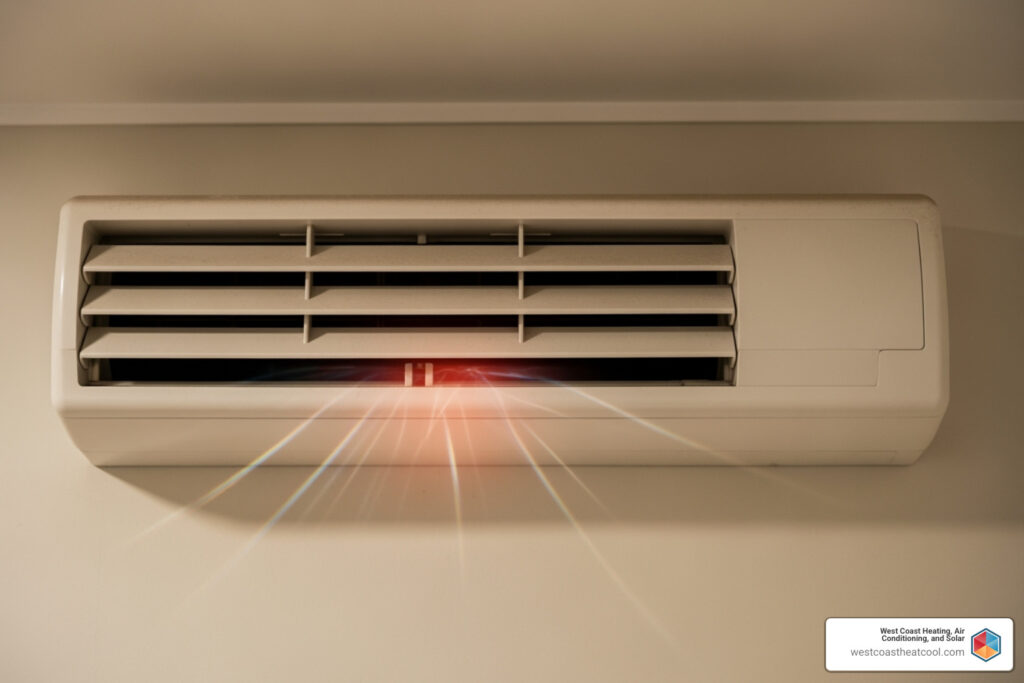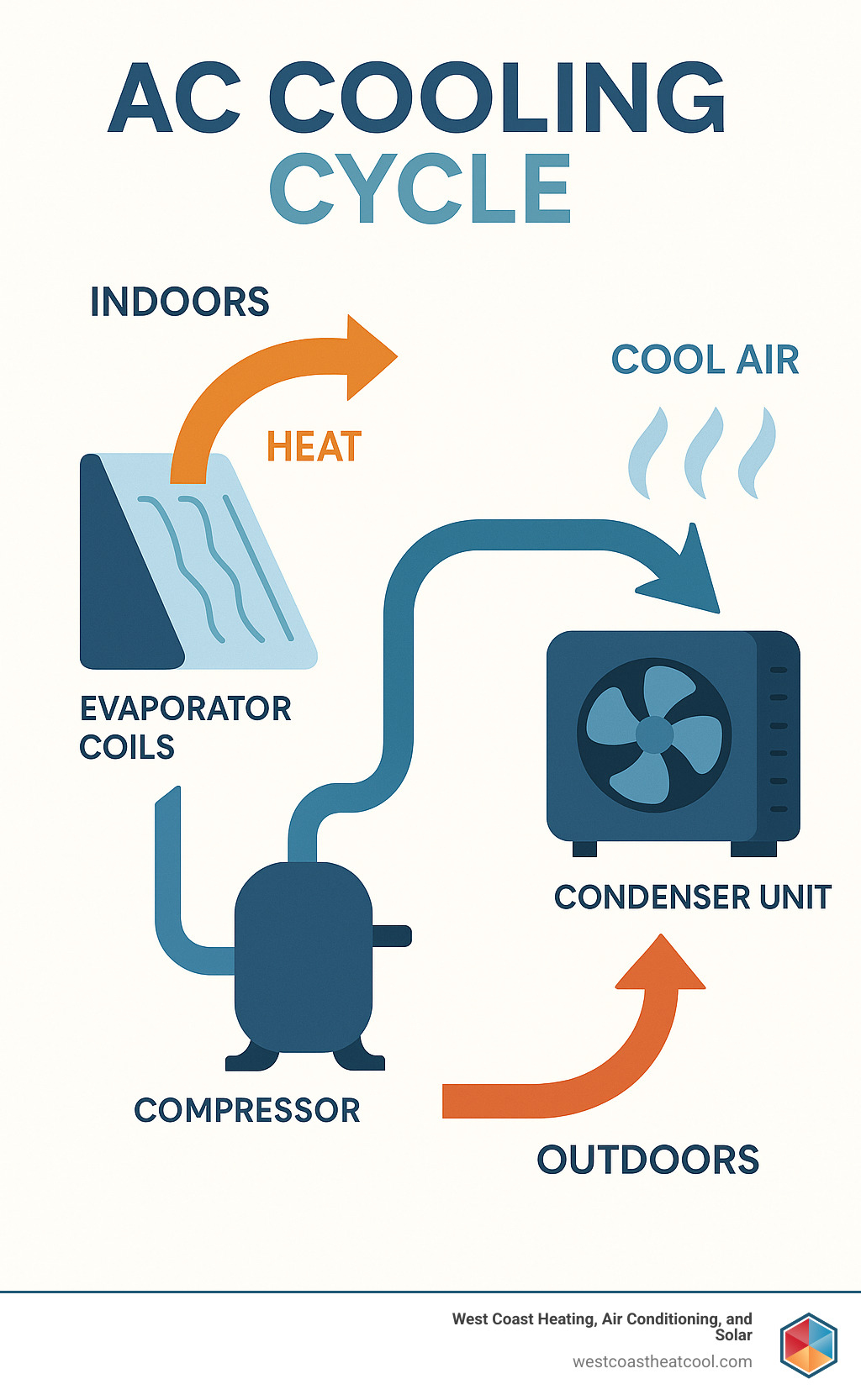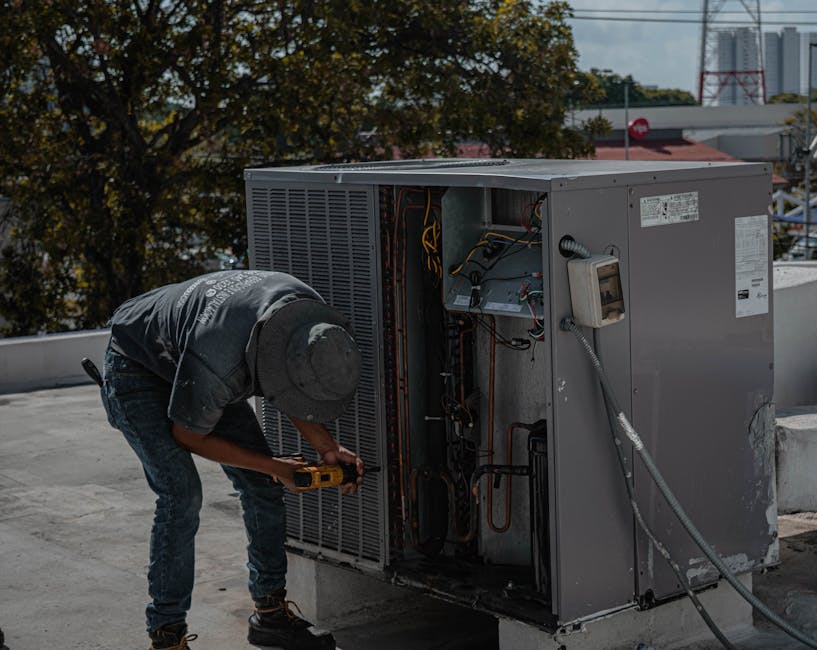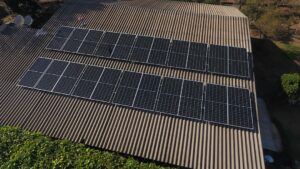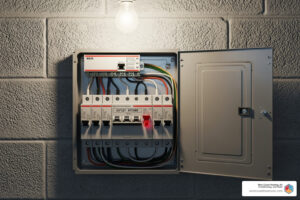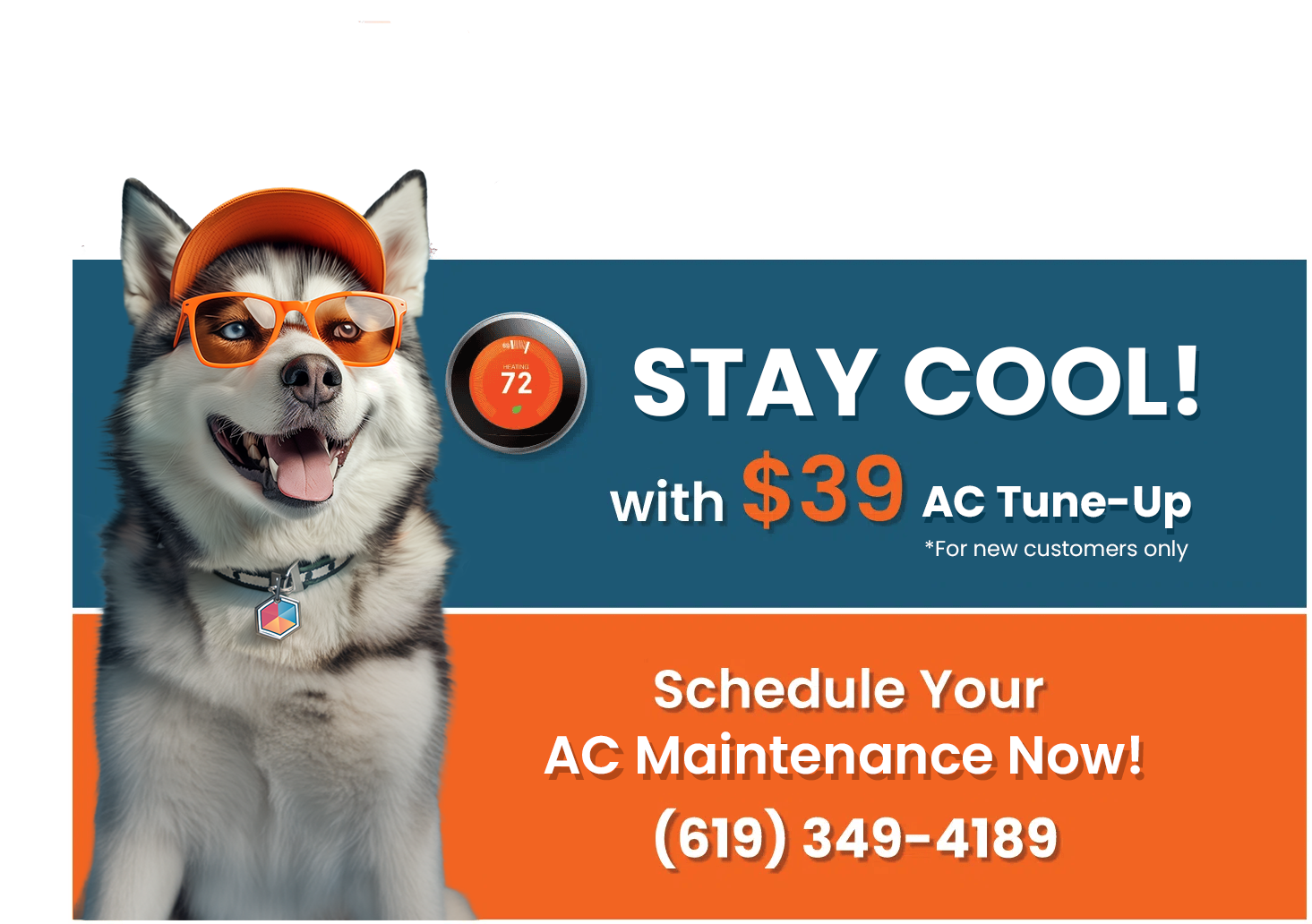When Your AC Becomes a Heater: Understanding the Problem
Nothing ruins a San Diego summer day quite like coming home to find your AC blowing hot air instead of the cool relief you expect. It’s frustrating, uncomfortable, and can leave you wondering what went wrong with your cooling system.
Quick Answer: Common causes of AC blowing hot air include:
- Thermostat issues – Wrong settings or dead batteries
- Dirty air filter – Restricts airflow and system performance
- Tripped circuit breaker – Cuts power to outdoor unit
- Frozen evaporator coils – Blocks proper heat exchange
- Refrigerant leaks – Prevents heat absorption
- Electrical problems – Faulty capacitors or compressor issues
The good news? Some of these problems have simple DIY fixes you can try before calling a professional. Others require expert attention to avoid costly damage or safety risks.
Your air conditioner doesn’t actually create cold air – it removes heat from your home’s air and transfers it outside. When this process breaks down at any point, you end up with warm air flowing through your vents instead of the cool comfort you need.
Understanding why your AC is blowing hot air helps you take the right steps quickly. Some fixes take just minutes and cost nothing. Others need professional repair to restore your system safely and efficiently.
Simple DIY Fixes: Your First Steps
When your home starts feeling more like a furnace than a refuge, don’t panic just yet. Before calling in the professionals, there are several straightforward troubleshooting steps that might solve your AC blowing hot air problem right away. These simple fixes can save you both time and money while giving you that satisfying feeling of solving the problem yourself.
Think of this as your AC detective work – we’re going to check the most common culprits first. Many homeowners are surprised to find that their cooling crisis has a surprisingly simple solution.
Check Your Thermostat Settings
Your thermostat is like the brain of your cooling system, so when it gets confused, everything else follows suit. You’d be amazed how often we get service calls that turn out to be simple thermostat mix-ups – it happens to the best of us!
Start with the basics: make sure your thermostat is set to “COOL” mode. It sounds obvious, but it’s easy to accidentally bump the switch or have a curious child “help” with the settings. If it’s accidentally set to “HEAT,” your system is actually working against you on those scorching San Diego days.
The fan setting makes a bigger difference than most people realize. When your fan is set to “ON,” it runs constantly, circulating whatever air is in your ducts – even when the cooling isn’t active. This means you might feel warm air coming from your vents and think your AC is blowing hot air when it’s really just moving uncooled room air around. Switch it to “AUTO” so the fan only runs when your system is actually cooling.
Don’t forget about those thermostat batteries. When they’re running low, your thermostat might send mixed signals to your AC or stop communicating altogether. A quick battery swap could be all you need to get back to cool comfort.
For more insights on avoiding common thermostat troubles, check out our guide on 4 Thermostat mistakes you’re likely to make in Chula Vista, CA. If your thermostat seems to have bigger issues, our article Is my thermostat beyond repair in Hillcrest, CA can help you figure out your next steps.
Inspect and Change the Air Filter
Here’s something that surprises many homeowners: a dirty air filter is one of the top reasons for an AC blowing hot air. This little component works harder than you might think, catching dust, pet hair, and all sorts of airborne particles before they can clog up your system.
When your filter gets clogged with debris, it’s like trying to breathe through a pillow – your AC just can’t get the airflow it needs. This creates a domino effect: your system works harder, uses more energy, and may even cause the evaporator coils to freeze up. When those coils freeze, your AC can’t absorb heat from your home, leaving you with warm air instead of cool relief.
Checking your filter is easy – just pull it out and hold it up to the light. If you can’t see through it or it looks visibly dirty, it’s time for a replacement. During our busy San Diego cooling season, you might need to change filters every month instead of the usual three months, especially if you have pets or family members with allergies.
The good news? Replacing an air filter is one of the simplest maintenance tasks you can do yourself. For more detailed help with airflow issues, take a look at our guide on Troubleshooting AC airflow problems.
Examine the Outdoor Unit and Breaker
Your outdoor unit – that big box sitting outside your home – has one crucial job: getting rid of all the heat your AC pulls from inside. When it can’t do this job properly, you’ll definitely notice warm air coming from your vents instead of cool.
Debris and blockages are common outdoor unit problems. Leaves, grass clippings, and dirt love to collect around and inside the unit. Even overgrown plants can restrict the airflow your condenser needs. Take a walk around your outdoor unit and clear away anything within about two feet of it. You can even gently rinse the accessible parts with your garden hose – just make sure to turn off the power first!
Sometimes the problem is electrical rather than mechanical. Your AC uses a lot of power, especially during hot weather when it’s working overtime. This can cause the circuit breaker to trip, cutting power to your outdoor unit while the indoor fan keeps running. The result? Your system just circulates uncooled air.
Check your electrical panel for any breakers that have flipped to the “off” position or are sitting halfway between “on” and “off.” Most AC systems have two breakers – one for indoor and one for outdoor components. If you find a tripped breaker, flip it firmly to “off,” wait about 30 seconds, then switch it back to “on.”
If the breaker trips again right away, don’t keep resetting it. This signals a more serious electrical issue that needs professional attention. For more information about this common problem, read our detailed guide on AC circuit breaker tripping.
Why Is My AC Blowing Hot Air? Deeper System Issues
When the simple fixes don’t solve your cooling crisis, it’s time to look deeper into your system. The issues we’re about to explore are more complex and typically require professional expertise. These aren’t weekend DIY projects – they involve intricate components, refrigerants, and electrical systems that need trained hands to handle safely.
Don’t feel discouraged if you’ve reached this point. Sometimes your AC blowing hot air is simply the result of normal wear and tear or issues that develop over time. The key is understanding what might be happening so you can make informed decisions about repairs.
The Problem of Frozen Evaporator Coils
Here’s something that surprises many homeowners: ice on your AC coils actually prevents cooling. When you find ice buildup on your evaporator coils (located inside your indoor air handler), your AC will definitely blow hot air instead of the cool relief you need.
Think of frozen coils as wearing a thick winter coat in the desert. The ice acts like insulation, blocking the coils from doing their job of absorbing heat from your home’s air. Instead of cool air flowing through your vents, you get warm, unconditioned air that hasn’t been properly cooled.
Several culprits can cause coil freezing. Restricted airflow from dirty filters, blocked vents, or collapsed ductwork is the most common cause. Low refrigerant levels create pressure drops that make the remaining refrigerant get dangerously cold. A clogged condensate drain can cause water backup and freezing, while a weak blower motor simply can’t move enough air over the coils.
If you spot frozen coils, turn off your AC immediately at the thermostat and switch the fan to “ON” if possible. This helps the ice melt naturally. You can also turn the entire system off and let it thaw for several hours. Once melted, check your air filter and clear any blocked vents.
But here’s the important part: if those coils freeze again, you’re dealing with a deeper problem that needs professional attention. For more insights specific to our San Diego climate, check out What causes frozen AC units in San Diego, CA.
Understanding Refrigerant Leaks and Why Your AC is Blowing Hot Air
Refrigerant is truly the lifeblood of your cooling system. This special substance absorbs heat from your indoor air and carries it outside, creating the cooling effect you depend on. When refrigerant leaks out, your system simply can’t absorb enough heat, leaving you with an AC blowing hot air.
Here’s what many people don’t realize: refrigerant doesn’t get “used up” like gasoline in your car. It circulates in a closed loop system, so if levels are low, there’s always a leak somewhere. Your system might run, but it’s like trying to fill a bucket with a hole in the bottom.
You might notice hissing or gurgling sounds as refrigerant escapes from your system. Ice formation on refrigerant lines or coils often signals low refrigerant levels. Your AC will struggle with reduced cooling performance, running longer cycles and driving up your energy bills. Sometimes you’ll spot an oily residue around refrigerant lines – that’s refrigerant mixed with system oil.
While you might try a simple soap bubble test on visible outdoor unit connections (apply soapy water and look for bubbles), refrigerant work requires professional handling. These substances can be toxic, and the repair process involves specialized equipment and certification.
If you have an older system using R22 refrigerant (common in units made before 2010), repairs can be especially costly since R22 production has ended. Sometimes replacement makes more financial sense than repeated repairs. Learn more about the cooling process and explore What causes AC refrigerant leaks.
Electrical Faults and a Failing Compressor
When electrical components fail or your compressor starts giving up, you’re looking at some of the most serious reasons your AC might be blowing hot air. These issues always require professional expertise due to high voltage electricity and pressurized refrigerant systems.
Capacitors provide the electrical boost needed to start your compressor and fan motors. When they fail, motors might not start at all or run intermittently, creating insufficient cooling. Contactors act like high-voltage switches for your compressor and outdoor fan – when they malfunction, these crucial components lose power even while your indoor fan keeps blowing uncooled air. Deteriorating wiring can disrupt power flow to various system components.
Your blower motor plays a crucial role too. Located in your indoor unit, it moves air across the evaporator coils and pushes conditioned air through your home’s ductwork. A failing blower motor can’t move enough air, leading to frozen coils and poor air distribution. Even if cooling happens at the coils, that cool air never reaches your living spaces effectively.
The compressor is your system’s heart, circulating refrigerant and creating the pressure changes essential for heat transfer. When it fails, the entire cooling cycle stops. You might hear unusual noises like chattering, ticking, grinding, or loud buzzing from your outdoor unit. A failing compressor often trips circuit breakers repeatedly by drawing excessive electricity. In severe cases, you’ll get no cooling at all or the unit won’t turn on.
These electrical and mechanical issues require immediate professional attention. High voltage electricity and pressurized refrigerant create serious safety hazards for untrained individuals. Regular maintenance can prevent many of these failures before they leave you sweltering. For more guidance on unusual sounds, read about AC is making buzzing noise, and learn how to Prevent AC compressor failure.
Prevention and When to Call a Professional
Nobody wants to deal with an AC blowing hot air on a scorching San Diego day, but knowing when to tackle the problem yourself versus calling in the pros can save you time, money, and a lot of frustration. While we absolutely encourage homeowners to try the simple fixes we’ve covered, there’s a fine line between helpful DIY troubleshooting and potentially dangerous territory.
Risks of Ignoring the Problem
Here’s the tough truth: hoping your AC blowing hot air problem will magically fix itself is like wishing your car will start running better if you just ignore that check engine light. It rarely works out that way, and the consequences can be pretty costly.
When you keep running an AC that’s struggling to cool your home, you’re essentially asking it to work overtime every single day. Think about it – if your system can’t cool efficiently, it’s going to run longer and harder trying to reach your thermostat setting. This extra strain leads to component damage that could have been easily prevented with timely repairs.
We’ve seen too many situations where a simple refrigerant leak turned into a completely burned-out compressor because the homeowner waited “just a few more weeks” to call for service. That small leak repair might have cost a few hundred dollars, but replacing a compressor? That’s often thousands.
Your energy bills will also take a serious hit. An inefficient AC system is like having a gas-guzzling car – it’s working twice as hard to get half the results. During peak summer months in places like Chula Vista or Escondido, this can add hundreds of dollars to your monthly electric bill.
Perhaps most concerning is the potential for poor indoor air quality. When your AC isn’t functioning properly, humidity levels can spike, creating the perfect breeding ground for mold and mildew. This isn’t just about comfort anymore – it’s about your family’s health, especially if anyone has allergies or respiratory issues. Black mold exposure can cause serious health problems that go far beyond a temporarily warm house.
The bottom line? Ignoring AC problems doesn’t make them go away – it just makes them more expensive and potentially dangerous.
The Value of Regular AC Maintenance
The best way to prevent your AC from blowing hot air isn’t waiting until something breaks – it’s staying ahead of problems before they start. Think of AC maintenance like getting regular oil changes for your car. You wouldn’t skip those and expect your engine to run smoothly forever, right?
During a professional tune-up, our technicians can spot the early warning signs that homeowners typically miss. We’re talking about things like slightly low refrigerant levels, electrical connections that are starting to corrode, or coils that are getting dirty but haven’t completely blocked airflow yet. Catching these issues early means fixing them while they’re still minor and inexpensive.
Regular maintenance also keeps your system running at peak efficiency. We clean those hard-to-reach condenser coils, check and tighten electrical connections, lubricate moving parts, and ensure your refrigerant levels are exactly where they should be. This isn’t just about preventing breakdowns – it’s about making sure your AC doesn’t have to work any harder than necessary to keep your home comfortable.
The financial benefits are pretty compelling too. A well-maintained AC system uses less energy, which directly translates to lower monthly utility bills. Over the course of a year, the money you save on electricity often pays for the maintenance visit itself. Plus, regular care significantly extends your system’s lifespan, helping you avoid that major expense of premature replacement.
Most importantly, regular maintenance gives you peace of mind. When summer temperatures soar across San Diego County, you’ll have confidence that your system is ready to handle whatever Mother Nature throws at it. No more crossing your fingers every time you adjust the thermostat, wondering if today’s the day your AC decides to quit.
We recommend scheduling your annual tune-up in the spring, before the real heat hits. This timing ensures any issues are resolved before you actually need your AC to work its hardest. For comprehensive year-round care and additional savings, consider our AC maintenance San Diego, CA services – because preventing problems is always easier than fixing them.
Frequently Asked Questions about an AC Blowing Hot Air
When your AC is blowing hot air, you probably have a dozen questions racing through your mind. We’ve been helping San Diego County homeowners since 1996, so we’ve heard just about every concern imaginable. Here are the answers to the most common questions that come up when your cooling system decides to become a heater instead.
Should I turn my AC off if it’s blowing warm air?
Yes, turn it off immediately! This is one of the most important steps you can take to protect your system and your wallet. When your AC is blowing hot air, continuing to run it is like driving a car with steam pouring from the radiator – you’re just making things worse.
Running a malfunctioning AC forces your system to work overtime without actually cooling your home. This puts tremendous strain on expensive components like the compressor, which can cost thousands to replace. What might start as a simple $200 repair can quickly escalate into a major system replacement if you keep running the unit.
Beyond preventing damage, turning off your AC also stops the energy waste. A broken system consumes just as much electricity as a working one, sometimes more, while providing zero cooling benefit. Your electric bill will thank you for making this smart decision.
Once you’ve turned it off, you can safely check the simple fixes we mentioned earlier – thermostat settings, air filter condition, and circuit breakers. If those don’t solve the problem, leave the system off until a professional can diagnose the issue.
What is the typical cost to fix an AC that blows warm air?
The cost to repair an AC blowing hot air typically ranges from $150 to $600, but the exact amount depends entirely on what’s causing the problem. Think of it like going to the doctor – a simple prescription costs less than surgery.
Simple issues often have minimal costs. Replacing a dirty air filter yourself costs under $20. Resetting a tripped breaker costs nothing. Even if you call us out for these basic problems, you’re looking at a minimal service call fee.
Common repairs fall in the middle range. Replacing a faulty capacitor, cleaning dirty coils, or fixing a minor refrigerant leak usually runs between $200 and $500. These are the bread-and-butter repairs that most homeowners encounter at some point.
Major problems can push costs much higher. Compressor replacement, extensive refrigerant line repairs, or electrical system overhauls can easily exceed $1,000. Sometimes these major repairs make more financial sense to put toward a new, more efficient system instead.
The key is getting an accurate diagnosis quickly. The longer you wait, the more likely a small problem becomes a big one. We always provide upfront pricing so you can make an informed decision about your repair.
How long should an AC cooling cycle last?
Your AC should run for about 15 minutes per cooling cycle on a typical San Diego summer day. This gives the system enough time to effectively cool your home without overworking itself. It’s like a comfortable jog rather than an exhausting marathon.
If your AC runs for 30 minutes or longer per cycle, or seems to run constantly without reaching your set temperature, something’s definitely wrong. Long cycles often indicate your system is struggling with restricted airflow from a dirty filter, low refrigerant levels, or other efficiency problems.
Constantly running AC units not only drive up your energy bills but also wear out components much faster than they should. Your system needs those brief rest periods between cycles to operate efficiently and last its full lifespan.
When you notice unusually long cycles, it’s time to investigate. Check your air filter first – it’s the most common culprit. If that’s clean and your system still runs excessively, give us a call. We can quickly identify what’s making your AC work so hard and get it back to those healthy 15-minute cycles that keep your home comfortable without breaking the bank.
Get Your Cool Air Back Today
Finding your AC blowing hot air on a sweltering San Diego day can feel like a nightmare, but you’re now armed with the knowledge to tackle this frustrating problem head-on. We’ve walked through everything from the simple fixes that take just minutes to the more complex issues that need professional attention.
Start with the basics we covered in our troubleshooting guide. Check your thermostat settings, swap out that dirty air filter, and take a peek at your outdoor unit. These simple steps often solve the problem without costing you a dime. It’s amazing how many times we’ve seen homeowners restore their cool comfort just by flipping a switch or clearing some debris.
But here’s the thing – sometimes your AC blowing hot air signals deeper problems that you shouldn’t tackle alone. Refrigerant leaks, electrical faults, and compressor issues are serious business. Trying to fix these yourself can turn a manageable repair into a costly disaster, not to mention the safety risks involved.
That’s where we come in. At West Coast Heating, Air Conditioning, and Solar, we’ve been keeping San Diego County homes comfortable since 1996. Whether you’re in Chula Vista dealing with frozen coils or in San Marcos facing a refrigerant leak, our team knows how to diagnose problems quickly and fix them right the first time.
We understand that AC blowing hot air doesn’t wait for convenient timing. That’s why we offer comprehensive solutions, flexible financing options, and club memberships that keep your system running smoothly year-round. Our customer-centric approach means we’re not just here to fix your immediate problem – we’re here to prevent future headaches too.
Don’t suffer through another uncomfortable day hoping your AC will magically start working. The longer you wait, the more damage your system might sustain, and the higher your energy bills will climb.
Ready to get your cool air back? Schedule your AC repair service in El Cajon or anywhere else in our service area. Let us bring back the refreshing comfort your San Diego home deserves!

